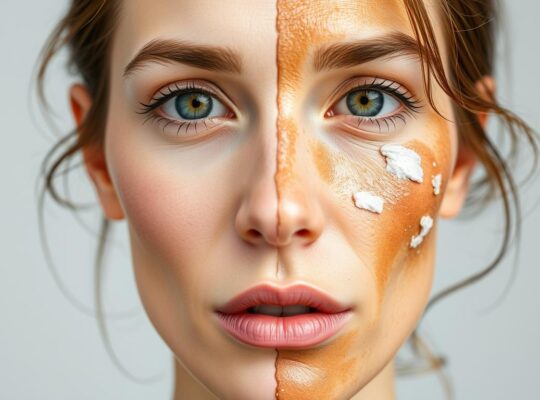Why Is a Morning Skincare Routine So Important?
Ever wondered why your skin doesn’t look as fresh and glowing in the morning as you’d like? The secret might lie in your morning skincare routine. The right steps can make all the difference between a dull complexion and radiant, healthy skin. But what exactly are the must-have steps in a morning skincare routine?
Why Your Morning Skincare Routine Matters
Your morning skincare routine isn’t just about looking good; it’s about preparing and protecting your skin for the day ahead. Throughout the day, your skin faces various environmental stressors like UV rays, pollution, and blue light from screens. A good morning routine creates a barrier between your skin and these harmful elements, helping to prevent early signs of aging, sun damage, and other skin issues.
What Are the Essential Skincare Steps for Glowing Skin?
Let’s break down the must-have steps in your morning skincare routine to ensure your skin stays glowing, healthy, and protected all day long.
Step 1: Cleanse Your Face
The foundation of any good skincare routine is a clean canvas. Washing your face in the morning is essential to remove the dirt, oil, and bacteria that have accumulated overnight.
Why You Need to Cleanse in the Morning
Cleansing your face in the morning helps to:
- Remove any sweat or oil produced during the night.
- Prepare your skin to absorb the products you’ll apply later.
- Create a fresh start for your skin, allowing it to breathe and function properly.
How to Cleanse Your Face in the Morning
- Choose the Right Cleanser: Opt for a gentle, sulfate-free cleanser that suits your skin type. If you have dry or sensitive skin, a hydrating cleanser with ingredients like ceramides is ideal. For oily or acne-prone skin, look for a cleanser with salicylic acid to help control oil production.
- Use Lukewarm Water: Hot water can strip your skin of its natural oils, so stick to lukewarm water when washing your face.
- Massage Gently: Apply the cleanser to your face and massage in circular motions for about 30 seconds to a minute. Be gentle to avoid irritating your skin.
- Rinse and Pat Dry: Rinse off the cleanser thoroughly and pat your face dry with a clean, soft towel.
Step 2: Apply a Toner
Toning is often overlooked, but it’s a crucial step in maintaining your skin’s balance. A good toner helps to restore your skin’s natural pH level, which can be disrupted by cleansing.
Benefits of Using a Toner
- Balances pH Levels: Cleansing can alter your skin’s pH, making it more alkaline. A toner helps restore it to its natural state.
- Hydrates the Skin: Many toners contain hydrating ingredients like hyaluronic acid, which help keep your skin moist and plump.
- Prepares Skin for the Next Steps: A toner can enhance the absorption of the serums and moisturizers you apply afterward.
How to Use a Toner
- Choose a Toner Based on Your Skin Type: For oily skin, opt for a toner with ingredients like witch hazel or salicylic acid. If you have dry skin, choose a toner with hydrating ingredients like glycerin or rose water.
- Apply with a Cotton Pad or Hands: Pour a small amount of toner onto a cotton pad or your hands and gently press it onto your face. Avoid rubbing, as this can cause irritation.
- Let It Absorb: Allow the toner to absorb into your skin before moving on to the next step.
Step 3: Use an Antioxidant Serum
Antioxidant serums, particularly those with Vitamin C, are powerhouses in your skincare routine. They help protect your skin from free radicals, which can cause premature aging and dullness.
Why You Should Use a Vitamin C Serum
Vitamin C is known for its brightening and anti-aging properties. It:
- Protects Against Sun Damage: While not a substitute for sunscreen, Vitamin C provides an extra layer of protection against harmful UV rays.
- Brightens Skin: Vitamin C helps reduce the appearance of dark spots and gives your skin a radiant glow.
- Boosts Collagen Production: This essential nutrient helps in the production of collagen, which keeps your skin firm and youthful.
How to Apply Vitamin C Serum
- Choose the Right Formula: Look for a serum with 10-20% Vitamin C. Higher concentrations may be too strong for sensitive skin.
- Apply After Toner: Once your toner has fully absorbed, apply a few drops of Vitamin C serum to your face and neck. Gently press it into your skin.
- Follow with Moisturizer: After the serum is absorbed, it’s time to lock in that moisture.
Step 4: Moisturize Well
Moisturizing is a critical step that keeps your skin hydrated and protected throughout the day. No matter your skin type, you need a good moisturizer to maintain your skin’s moisture barrier.
Why Moisturizing is Essential
- Prevents Dryness: Moisturizer helps to lock in moisture, preventing your skin from becoming dry and flaky.
- Protects the Skin: A good moisturizer creates a protective barrier on your skin, shielding it from environmental pollutants.
- Improves Skin Texture: Regular moisturizing keeps your skin smooth and soft, improving its overall texture.
How to Moisturize for Maximum Benefits
- Choose a Moisturizer for Your Skin Type: For oily skin, a lightweight, oil-free moisturizer works best. If you have dry skin, opt for a richer, creamier formula.
- Apply on Damp Skin: For better absorption, apply your moisturizer on slightly damp skin. This helps lock in the moisture.
- Don’t Forget Your Neck: Your neck deserves just as much care as your face. Apply moisturizer to your neck in upward strokes.
Step 5: Apply Sunscreen
Never skip sunscreen—it’s the most critical step in your morning skincare routine. Sunscreen protects your skin from the harmful effects of UV rays, which can cause premature aging, sunburn, and even skin cancer.
Why Sunscreen is Non-Negotiable
- Prevents Premature Aging: UV rays can cause wrinkles, fine lines, and age spots. Sunscreen helps protect your skin from these signs of aging.
- Reduces Risk of Skin Cancer: Regular use of sunscreen significantly lowers the risk of developing skin cancer.
- Protects Against Sunburn: Sunscreen shields your skin from the painful effects of sunburn.
How to Use Sunscreen Effectively
- Choose a Broad-Spectrum Sunscreen: Look for a sunscreen that offers broad-spectrum protection, meaning it protects against both UVA and UVB rays. An SPF of at least 30 is recommended for daily use.
- Apply Generously: Don’t skimp on sunscreen. Use about a nickel-sized amount for your face and a shot glass worth for your body.
- Reapply as Needed: If you’re spending time outdoors, reapply sunscreen every two hours or immediately after swimming or sweating.
Bonus Tips for a Glowing Morning Skincare Routine
Now that you’ve got the basics down, here are a few extra tips to take your morning skincare routine to the next level:
Use a Hydrating Mist
- Hydrate Throughout the Day: Spritz a hydrating mist over your face whenever you need a moisture boost. It’s especially helpful in dry or air-conditioned environments.
Don’t Forget Your Eyes
- Protect and Nourish: The skin around your eyes is delicate and prone to dryness and wrinkles. Use a hydrating eye cream to keep this area smooth and youthful.
Prime for Makeup
- Enhance Makeup Longevity: If you wear makeup, using a primer after your sunscreen can help your makeup last longer and apply more smoothly.
FAQ:
Q: Can I skip any of these steps if I’m in a rush?
A: While it’s always best to follow all steps, if you’re short on time, cleansing and applying sunscreen are the most critical. If possible, also apply a moisturizer to keep your skin hydrated.
Q: Can I use the same products in my morning and evening routines?
A: Some products, like your cleanser and moisturizer, can be used both morning and night. However, it’s essential to use a sunscreen in the morning and save any retinoids or heavier treatments for the evening.
Q: How often should I exfoliate in the morning?
A: Exfoliation## Start Your Day Right: The Ultimate Morning Skincare Routine for Healthy Skin













